 March 15, 2018 John E. Ross, KD8IDJ, Editor
| ||||||
Why ARRL is Recommending Enhanced HF Privileges for Technicians ARRL has asked the FCC to expand HF privileges for the entry-level Technician license to include limited phone privileges on 75, 40, and 15 meters, plus RTTY and digital mode privileges on 80, 40, and 15 meters, where Technicians already have CW privileges. ARRL believes the additional digital privileges will attract younger people to Amateur Radio.
Some in the Amateur Radio community have questioned the need for expanded Technician privileges or to express other perspectives. ARRL has responded to point out some of the key advantages of its petition, which recognizes the tremendous technological advances and changes in Amateur Radio. Some key points:
ARRL to Shine Spotlight on Public Service Communications at Hamvention 2018 Hamvention® 2018 is May 18-20 at the Greene County Fairgrounds and Expo Center in Xenia, Ohio. The largest annual Amateur Radio gathering in the US, this year's event has been sanctioned as the 2018 ARRL Great Lakes Division Convention. The theme for this year's Hamvention is "Amateur Radio...Serving the Community." ARRL has responded in that spirit, and four ARRL-sponsored forums -- to include many guest presenters -- will comprise a Public Service Communications track on Friday and Saturday of Hamvention.
"Building Partnerships," with ARRL Emergency Preparedness Manager Mike Corey, KI1U, and FEMA Community Partners Specialist, External Affairs Sarah Byrne as co-presenters, will begin at 11:50 AM on Friday. Acknowledging that collaborative and mutually beneficial partnerships are key to successful disaster and emergency response, this session will explore how Amateur Radio public service groups rely on such partnerships when serving their communities. Corey and Byrne will address how to build and grow partnerships of different levels of complexity across a wide range of interests and organizations -- from Voluntary Organizations Active in Disasters (VOADs), to other nonprofits and commercial entities.
Corey also will moderate a panel discussion on Saturday at 9:15 AM. This session will offer a chance to hear from representatives of Amateur Radio's largest organizations and partnerships that are active during times of disaster and emergency. "Stories from the 2017 Hurricanes" is ARRL's final forum in the Public Service Communications track. It will take place at 1:30 PM on Saturday. Special guests will share firsthand accounts of Amateur Radio's response to the 2017 hurricanes in Puerto Rico, US Virgin Islands, and across the southeastern US. Speakers will include ARRL Section Manager (SM) for Puerto Rico, Oscar Resto, KP4RF; US Virgin Islands SM Fred Kleber, K9VV, and Andy Anderson, KE0AYJ, who was among the Amateur Radio operators organized by ARRL as American Red Cross volunteers who deployed to Puerto Rico in the wake of Hurricane Maria. Anderson and fellow volunteer -- and Hamvention Amateur of the Year -- Val Hotzfeld, NV9L, who also deployed to Puerto Rico, will be keynote speakers at the 2018 ARRL Donor Recognition Reception on the Thursday evening before Hamvention. People who attend three or more of the ARRL-sponsored Public Service Communications forums will earn an ARRL certificate in recognition of their commitment to ham radio public service training and development.
The centerpiece of the ARRL's participation at Hamvention is ARRL EXPO 2018, a spacious exhibit area that will be located in Building 2 at the Greene County Fairgrounds and Expo Center. Corey and Bailey have organized an Amateur Radio Public Service exhibit for ARRL EXPO, which will include a small stage and seating so attendees can enjoy 15-minute public-service-themed presentations throughout the convention.
Other ARRL highlights at Hamvention 2018 include the popular ARRL Member Forum, moderated by ARRL Great Lakes Division Director Dale Williams, WA8EFK. The ARRL Member Forum -- at noon on Saturday in Room 3 -- is your opportunity to hear from national and local ARRL officials on key areas of member interest. All are welcome. On Friday at 2:25 PM in Room 3, "ARRL International Grid Chase 2018 -- Get in the Chase!" will offer an update on ARRL's year-long on-the-air event aimed at working as many grid squares as possible before next year. ARRL Contest Branch Manager Bart Jahnke, W9JJ, will provide tips on participating, uploading your contact data to ARRL's Logbook of The World (LoTW), scoring, and awards.
"Reaching the Public with Ham Radio" will be the focus on Sunday from 9:15 AM to 10:15 AM, in Room 2. Presenters will be Tommy Gober, N5DUX, an ARRL Teachers Institute on Wireless Technology instructor, and ARRL Marketing Manager Bob Inderbitzen, NQ1R. Many radio clubs organize displays and exhibits to garner interest for Amateur Radio. They recruit new hams at Maker Faires, school and Scouting events, county fairs, public events, and science and technology conventions. Clubs also set up displays for the general public during ARRL Field Day. Participants will learn and share different methods for organizing exhibits and engaging the public at non-radio events. A complete list of Hamvention forums is on the Hamvention website. Purchase Hamvention tickets online. The Doctor Will See You Now! The Doctor opens the mailbag for the newest (March 15) episode of the "ARRL The Doctor is In" podcast. Listen...and learn!
Every 2 weeks, your host, QST Editor-in-Chief Steve Ford, WB8IMY, and the Doctor himself, Joel Hallas, W1ZR, will discuss a broad range of technical topics. You can also e-mail your questions to doctor@arrl.org, and the Doctor may answer them in a future podcast. Enjoy "ARRL The Doctor is In" on Apple iTunes, or by using your iPhone or iPad podcast app (just search for "ARRL The Doctor is In"). You can also listen online at Blubrry, or at Stitcher (free registration required, or browse the site as a guest) and through the free Stitcher app for iOS, Kindle, or Android devices. If you've never listened to a podcast before, download our beginner's guide. 2018 ARRL International Grid Chase Update Our second month of the 2018 ARRL International Grid Chase (IGC) is now in the books. Big numbers continue on the bands, with overall reporting up by more than 5% from January. While WARC and VHF+ band activity dipped a bit, activity was up on the other HF bands. As evidenced by how many amateurs participated in February, per the leader board, the month saw 22,121 participants (logbook accounts = station locations). March is off and running with more than 14,600 logbook accounts -- through March 12 at 1200 UTC. Months start out strong because the leaderboard resets, allowing repeat contacts.
Activity in late February and early March also benefitted from the ARRL International DX Contest CW and phone weekends. ARRL's social media feeds have been humming with lots of IGC chatter. A couple group activities that caught our attention included posts by Bob Lindsay, W8MRL, who is tracking the IGC activities of Ohio hams, and by Paul Gacek, W6PNG, and the TI/WJ1B team who mounted a DXpedition to Costa Rica (EK70) for the couple of weeks around the time of the ARRL DX Phone weekend. In addition to Gacek, the team included Buddipole CEO/Owner Chris Drummond, W6HFP; ARRL Dakota Division Director Matt Holden, K0BBC, and retired ARRL COO Harold Kramer, WJ1B. Complete Grid Chase information is always available on the ARRL website. Also visit the IGC 2018 Facebook page. ARRL 2018 International Grid Chase gear now is available from the ARRL Store. You can buy IGC t-shirts, coffee mugs, pins, and stickers, as well as an IGC North America map, grid square map, and grid square atlas. -- Thanks to ARRL Contest Branch Manager Bart Jahnke, W9JJ AmazonSmile Triple Donation Promotion Now Under Way Triple your impact! Until March 31, Amazon is tripling the donation rate on your first AmazonSmile purchase.
For more information, visit AmazonSmile, and log in to your Amazon account. Digital QST App Update Now Available The digital QST app, upgraded to feature a new build from our digital publishing partner, is now available. This change only affects mobile users who read the digital edition of QST on their smartphones or tablets through the app; web browser use will not be affected. The update will look different from the current app, but provide the same function to read and download digital QST, plus some new features that have been frequently requested by members. These additions include the ability to:
Note that this update will delete any downloaded issues of QST accumulated on the app since ARRL changed digital publishing providers in December 2016. The instructional guide provides further details on using the new build. To see lists of mobile devices that are compatible with the digital QST app, visit the FAQs page and click the link for your corresponding mobile device. FT8 DXpedition Mode Field Test Attracts Upward of 500 Participants The "Fox" and the "Hounds" were on the bands March 6, as the WSJT-X development group conducted a field test of the still-beta FT8 DXpedition Mode. A second beta version of WSJT-X version 1.9.0, which includes the DXpedition-mode-capable version of FT8 -- was released recently. Version 1.9.0-rc2 was made available to allow further field testing of the FT8 DXpedition mode, which is designed to permit DXpeditions to make FT8 contacts at very high rates.
"The overwhelming majority of participating Hounds operated as intended, and according to instructions," Taylor said. "I copied 190 unique Hound call signs during the 2300 [UTC] hour -- when I was acting as Fox on 20 meters -- and 330 unique call signs during the whole 4 hours. I suppose that we had at least 400 - 500 participants, maybe more." Taylor said that depending on programming progress and his own schedule, the development team may schedule another public test in a few weeks. Read more. Chinese Lunar-Orbit Amateur Radio Payload Could Launch this Spring China's twin-launch Chang'e 4 mission to the far side of the moon will place a pair of microsatellites in lunar orbit this spring "to test low-frequency radio astronomy and space-based interferometry." The two satellites, unofficially called DSLWP-A1 and DSLWP-A2 (DSLWP = Discovering the Sky at Longest Wavelengths Pathfinder), could launch this spring.
The two spacecraft also will carry Amateur Radio and educational payloads, but not a transponder. Developed by students at the Harbin Institute of Technology, the Amateur Radio payload on DSLWP-A1 will provide a telecommand uplink and a telemetry and digital image downlink. Radio amateurs will be able to transmit commands that allow them to send commands to take and download an image.
Equipped with low-frequency antennas and receivers, the astronomy objectives of DSLWP-A1 and -A2 will be to observe the sky at the lower end of the electromagnetic spectrum -- 1 MHz to 30 MHz -- with the aim of learning about energetic phenomena from celestial sources. The launch is anticipated for May or June. Read more. Tennessee Middle School Students Will Send CubeSat into Space NASA has informed Robertsville Middle School in Oak Ridge, Tennessee, that its "RamSat" 2U CubeSat proposal has been accepted for participation in NASA's CubeSat Launch Initiative (CSLI) for a launch opportunity during 2019, 2020, or 2021. The Robertsville proposal was one of 21 satellites selected or prioritized for participation in the ninth CSLI selection. CSLI provides opportunities for small satellite payloads built by schools and nonprofit organizations to fly on upcoming launches. RamSat will be an educational mission to develop and implement a middle school STEM curriculum for building a CubeSat.
The students' plan for RamSat is to send a small camera and radio encased in a 2U nanosatellite that will relay data and images from space back to Earth. This will let students study reforestation patterns of vegetation lost in forest fires. The student mission arose in response to a real-world connection they had to the Gatlinburg, Tennessee, fires last year. "I can't think of a more exciting project to ignite the students' curiosity and passion for science and engineering," Thornton said. Read more. -- Thanks to AMSAT News Service via Oak Ridge Schools In Brief...
Getting It Right The article "History-Related Events Will Operate from Rare Grid in Cape Cod National Seashore," in The ARRL Letter for March 8 contained an error in the day of the week that the W1MGY Titanic memorial operation begins. It should have said, "Operation will begin on Thursday, April 12, at 9 AM ET..." The K7RA Solar Update Tad Cook, K7RA, Seattle, reports: The blank sun continues, with no sunspots observed since March 2, so the average daily sunspot number dropped from 1.6 to zero this week, and average daily solar flux rose fractionally from 67.6 to 67.7. Geomagnetic indicators were up slightly, with planetary A index increasing from 5.1 to 7.1, and mid-latitude A index rose from 4.6 to 5.7.
Predicted planetary A index is 18 on March 15; 15 on March 16-18; 10, 5, 7, and 5 on March 19-22; 10, 5, 8, and 20 on March 23-26; 5 on March 27-29; 8 on March 30-31; 5 on April 1-9; 8, 10, 14, 16, and 20 on April 10-14; 5 on April 15-16; 12, 18, 10, 5, 8, and 20 on April 17-22; 5 on April 23-25; 8 on April 26-27, and 5 on April 28. Sunspot numbers for March 8 through 14, 2018 were 0, 0, 0, 0, 0, 0, and 0, with a mean of 0. The 10.7-centimeter flux was 66.6, 67.5, 67.7, 67.8, 68.1, 68.6, and 67.7, with a mean of 67.7. Estimated planetary A indices were 4, 12, 12, 6, 3, 4, and 9, with a mean of 7.1. Estimated mid-latitude A indices were 3, 10, 9, 7, 2, 3, and 6, with a mean of 5.7. Send me your reports and observations. Just Ahead in Radiosport
See the ARRL Contest Calendar for more information. For in-depth reporting on Amateur Radio contesting, subscribe to The ARRL Contest Update via your ARRL member profile e-mail preferences. Upcoming ARRL Section, State, and Division Conventions
Find conventions and hamfests in your area.
. .
Subscribe to...
Free of charge to ARRL members...
Find ARRL on Facebook! Follow us on Twitter, Snapchat @ARRLHQ, and Instagram! | ||||||
 The proposed additional HF phone privileges are 3.900 to 4.000 MHz, 7.225 to 7.300 MHz, and 21.350 to 21.450 MHz. Technicians already have HF privileges on parts of 10 meters.
The proposed additional HF phone privileges are 3.900 to 4.000 MHz, 7.225 to 7.300 MHz, and 21.350 to 21.450 MHz. Technicians already have HF privileges on parts of 10 meters. "Getting Started in Public Service Communications," an introduction to public service communication training and emergency preparedness, will take place on Friday at 9:15 AM, moderated by Ken Bailey, K1FUG, the ARRL Emergency Preparedness Assistant and Continuing Education Program Administrator. He will cover the many ways that radio amateurs serve their communities in good times and in bad.
"Getting Started in Public Service Communications," an introduction to public service communication training and emergency preparedness, will take place on Friday at 9:15 AM, moderated by Ken Bailey, K1FUG, the ARRL Emergency Preparedness Assistant and Continuing Education Program Administrator. He will cover the many ways that radio amateurs serve their communities in good times and in bad.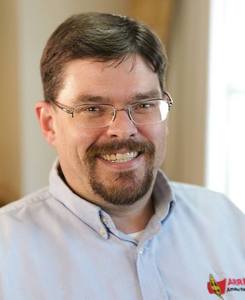
.jpg) Hamvention has also organized activities that fold into this year's public service theme. Preble County, Ohio, ARES Emergency Coordinator Gary Hollenbaugh, NJ8BB, has coordinated a display of mobile emergency communications vehicles and equipment at Hamvention for 10 years. "The purpose of the display is to promote emergency communications, and for groups who build and operate mobile communications facilities to display their equipment and demonstrate their capabilities," Hollenbaugh said. "It's also a chance for the groups to talk about how to develop emergency communications in the field and to exchange ideas with Hamvention visitors."
Hamvention has also organized activities that fold into this year's public service theme. Preble County, Ohio, ARES Emergency Coordinator Gary Hollenbaugh, NJ8BB, has coordinated a display of mobile emergency communications vehicles and equipment at Hamvention for 10 years. "The purpose of the display is to promote emergency communications, and for groups who build and operate mobile communications facilities to display their equipment and demonstrate their capabilities," Hollenbaugh said. "It's also a chance for the groups to talk about how to develop emergency communications in the field and to exchange ideas with Hamvention visitors."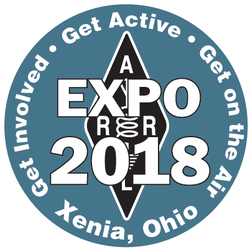 The exhibit will include a display of ARRL
The exhibit will include a display of ARRL 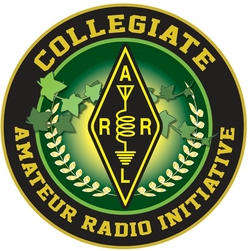 The ARRL Collegiate Amateur Radio Initiative Forum will gather on Saturday, 4-5 PM, in Room 3. Moderators will be Andy Milluzzi, KK4LWR, and his brother Tony Milluzzi, KD8RTT. A growing number of campus radio clubs and student radio amateurs are sharing ideas and suggestions on the ARRL Collegiate Amateur Radio Initiative (CARI)
The ARRL Collegiate Amateur Radio Initiative Forum will gather on Saturday, 4-5 PM, in Room 3. Moderators will be Andy Milluzzi, KK4LWR, and his brother Tony Milluzzi, KD8RTT. A growing number of campus radio clubs and student radio amateurs are sharing ideas and suggestions on the ARRL Collegiate Amateur Radio Initiative (CARI)  Sponsored by
Sponsored by 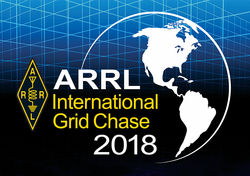 Last month, we reported that low sunspots and low winter E-skip and F2 motivated lower band participation. As spring takes hold, E-skip will bring up the MUF for upper HF (and VHF) bands, and tropospheric openings will fuel VHF-to-microwave openings as well.
Last month, we reported that low sunspots and low winter E-skip and F2 motivated lower band participation. As spring takes hold, E-skip will bring up the MUF for upper HF (and VHF) bands, and tropospheric openings will fuel VHF-to-microwave openings as well. Log
Log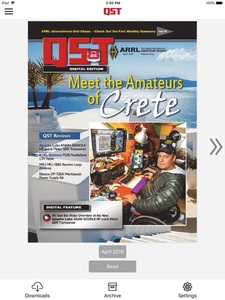 To help members adjust to the new look and functions, we have updated the app section of our instructional guide, which is linked from the
To help members adjust to the new look and functions, we have updated the app section of our instructional guide, which is linked from the .JPG) Developer Joe Taylor -- the "T" in FT8 -- has released a few highlights drawn from his observations during the public test. The "Fox" is the DXpedition station, while "Hounds" comprise the pileup. According to the
Developer Joe Taylor -- the "T" in FT8 -- has released a few highlights drawn from his observations during the public test. The "Fox" is the DXpedition station, while "Hounds" comprise the pileup. According to the 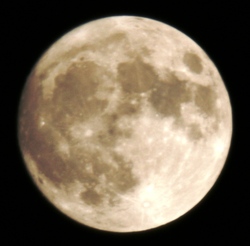 The pair represent the first phase of the Chang'e 4 mission, which involves placing a relay satellite in a halo orbit to facilitate communication with the Chang'e 4 lander and rover, which will be sent to the far side of the moon in December. Because the moon's far side never faces Earth, the satellite is needed to serve as an Earth-moon relay. The Chang'e 4 mission will be the first-ever attempt at a soft-landing on the far side of the moon.
The pair represent the first phase of the Chang'e 4 mission, which involves placing a relay satellite in a halo orbit to facilitate communication with the Chang'e 4 lander and rover, which will be sent to the far side of the moon in December. Because the moon's far side never faces Earth, the satellite is needed to serve as an Earth-moon relay. The Chang'e 4 mission will be the first-ever attempt at a soft-landing on the far side of the moon..jpg) The satellites will piggyback on the Chang'e 4 relay package and will deploy themselves into a 200 × 9,000 kilometer lunar orbits. The Harbin Institute of Technology team has proposed downlinks in the 435 and 436 MHz range.
The satellites will piggyback on the Chang'e 4 relay package and will deploy themselves into a 200 × 9,000 kilometer lunar orbits. The Harbin Institute of Technology team has proposed downlinks in the 435 and 436 MHz range.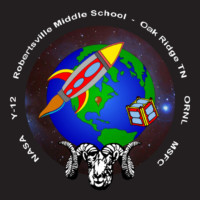 "This is such an exciting opportunity for the students!" said Peter Thornton, one of the RamSat team leaders from Oak Ridge National Laboratory. "They will now have the chance to design, build, carry out, and own a satellite mission. They will be the mission scientists, the communication specialists, and the logistics experts."
"This is such an exciting opportunity for the students!" said Peter Thornton, one of the RamSat team leaders from Oak Ridge National Laboratory. "They will now have the chance to design, build, carry out, and own a satellite mission. They will be the mission scientists, the communication specialists, and the logistics experts."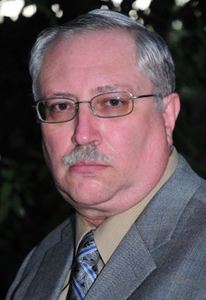 Paul Gilbert, KE5ZW, will succeed ARRL South Texas Section Manager Lee Cooper, W5LHC, who is stepping down. Cooper cited time constraints and the workload associated with his consulting business. "This was not an easy decision to make, but one I felt best for the future of our Section," Cooper said in a message to South Texas Section members. He has been South Texas SM since 2009. Gilbert will take the reins on April 1, to complete the current term of office that continues through September 30, 2019. Of Cedar Park, Gilbert is an Assistant Section Emergency Coordinator and Technical Specialist in the South Texas Section. He also serves as the West Gulf Division Assistant Director for Public Safety. He is a member of the Radio Club of America Board of Directors.
Paul Gilbert, KE5ZW, will succeed ARRL South Texas Section Manager Lee Cooper, W5LHC, who is stepping down. Cooper cited time constraints and the workload associated with his consulting business. "This was not an easy decision to make, but one I felt best for the future of our Section," Cooper said in a message to South Texas Section members. He has been South Texas SM since 2009. Gilbert will take the reins on April 1, to complete the current term of office that continues through September 30, 2019. Of Cedar Park, Gilbert is an Assistant Section Emergency Coordinator and Technical Specialist in the South Texas Section. He also serves as the West Gulf Division Assistant Director for Public Safety. He is a member of the Radio Club of America Board of Directors.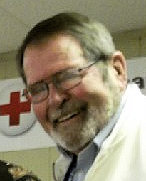 Past ARRL Louisiana Section Manager Jim Molan, KD5IGG, of Bunkie, Louisiana, died on March 8 after suffering a severe head injury in a fall. He was 84. Molan had served as Louisiana SM from 2014 until 2016 and was a Louisiana Section Field Organization volunteer prior to that, having served as Assistant Section Manager, Assistant Section Emergency Coordinator, District Emergency Coordinator, and Emergency Coordinator. Molan was a veteran of the Korean Conflict and later enlisted in the Louisiana National Guard, where he was a battalion tank leader. He retired from electric services company Cleco after some 40 years of service. A Red Cross volunteer, Molan was named as the National American Red Cross Disaster Relief Volunteer of the Year in 1997.
Past ARRL Louisiana Section Manager Jim Molan, KD5IGG, of Bunkie, Louisiana, died on March 8 after suffering a severe head injury in a fall. He was 84. Molan had served as Louisiana SM from 2014 until 2016 and was a Louisiana Section Field Organization volunteer prior to that, having served as Assistant Section Manager, Assistant Section Emergency Coordinator, District Emergency Coordinator, and Emergency Coordinator. Molan was a veteran of the Korean Conflict and later enlisted in the Louisiana National Guard, where he was a battalion tank leader. He retired from electric services company Cleco after some 40 years of service. A Red Cross volunteer, Molan was named as the National American Red Cross Disaster Relief Volunteer of the Year in 1997..jpg) Before shutting down on March 12, Z60A in Kosovo had logged 98,450 contacts during its celebratory operations to hand out a new one to the madding crowd. The 30-day-long initial activation of the newest DXCC entity encountered 30,541 individual call signs in 174 DXCC entities. "Mission Goodwill Kosovo" expressed appreciation to the 28 operators from various countries near and far who turned out to handle the pileups. The Z60A logs will be uploaded to Logbook of The World (LoTW) soon, and QSL cards will be at the printer's next week.
Before shutting down on March 12, Z60A in Kosovo had logged 98,450 contacts during its celebratory operations to hand out a new one to the madding crowd. The 30-day-long initial activation of the newest DXCC entity encountered 30,541 individual call signs in 174 DXCC entities. "Mission Goodwill Kosovo" expressed appreciation to the 28 operators from various countries near and far who turned out to handle the pileups. The Z60A logs will be uploaded to Logbook of The World (LoTW) soon, and QSL cards will be at the printer's next week. Radio amateurs around the world will celebrate Saint Patrick's Day on the air during the
Radio amateurs around the world will celebrate Saint Patrick's Day on the air during the 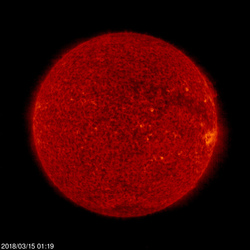 Predicted solar flux is 69 on March 15-22; 72 on March 23-29; 70 on March 30; 68 on March 31-April 11; 70 on April 12; 72 on April 13-25; 70 on April 26, and 68 on April 27-28.
Predicted solar flux is 69 on March 15-22; 72 on March 23-29; 70 on March 30; 68 on March 31-April 11; 70 on April 12; 72 on April 13-25; 70 on April 26, and 68 on April 27-28.







